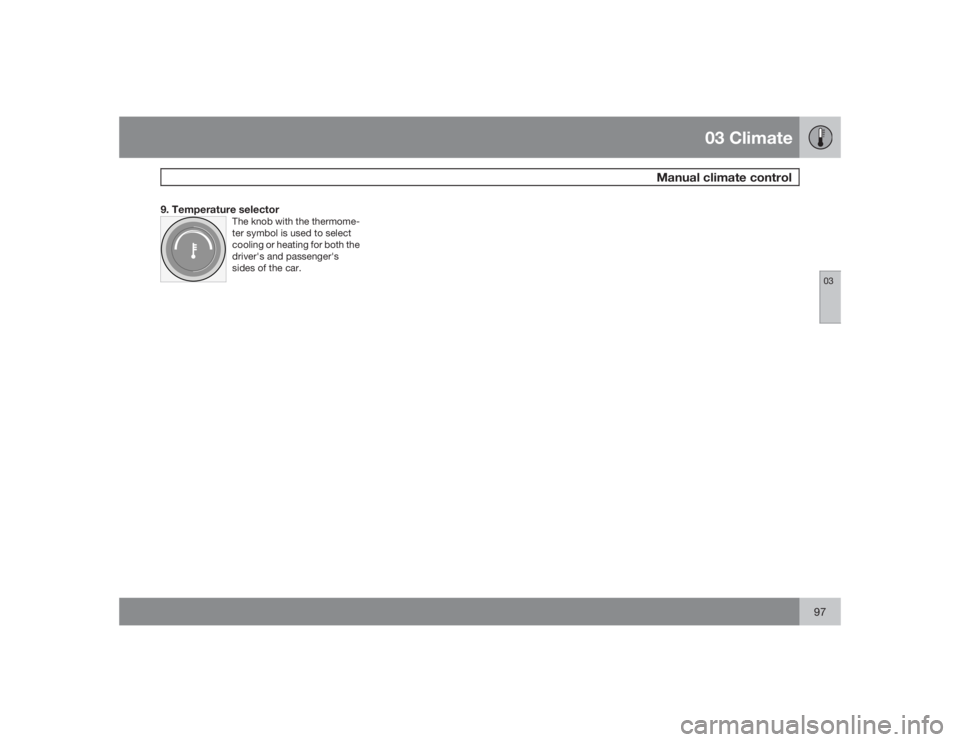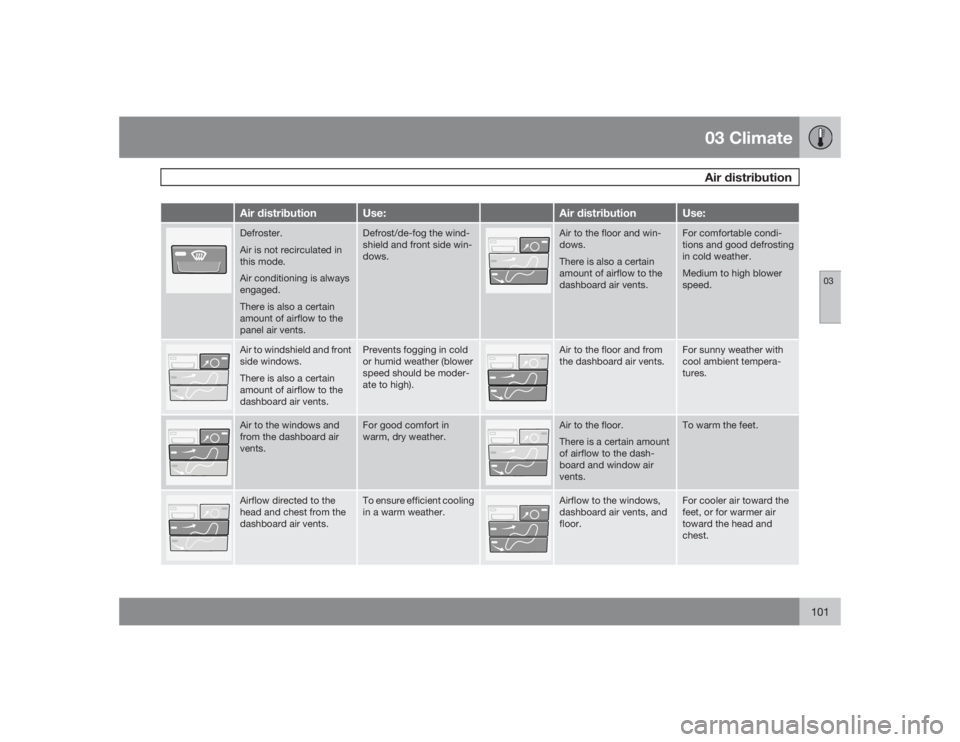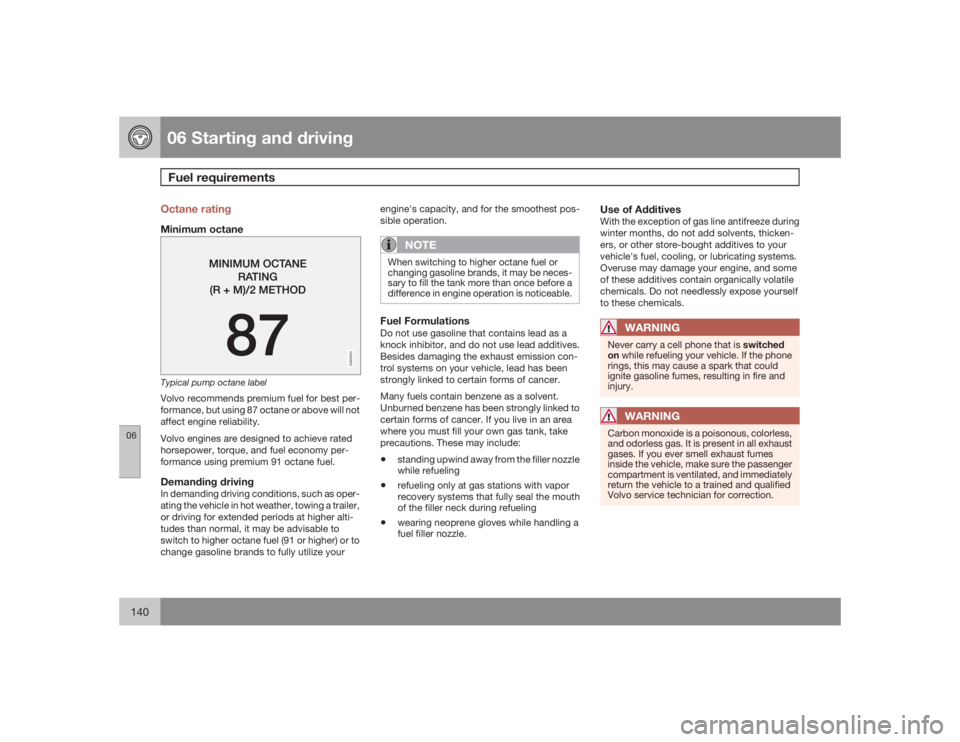2009 VOLVO S40 cooling
[x] Cancel search: coolingPage 54 of 286

02 Instruments and controlsInstrument panel
0254
odometer, trip odometers, optional rain
sensor, and cruise control.Trip odometer reset button – The trip
odometers are used to measure short dis-
tances. Press the button briefly to switch
between the odometer for the car's total
mileage and the two trip odometers, T1
and T2. A long press (more than 2 seconds)
resets the currently selected trip odometer.Temperature gauge – The gauge indicates
the temperature of the engine cooling sys-
tem. If the temperature is abnormally high
and the needle enters the red zone, a mes-
sage is shown in the display. Bear in mind
that auxiliary lamps in front of the air intake
reduce the cooling capacity at high outside
temperatures and high engine loads.Indicator and warning symbols
Page 97 of 286

03 Climate
Manual climate control
0397
9. Temperature selector
The knob with the thermome-
ter symbol is used to select
cooling or heating for both the
driver's and passenger's
sides of the car.
Page 101 of 286

03 ClimateAir distribution
03
101
Air distribution
Use:
Air distribution
Use:
Defroster.
Air is not recirculated in
this mode.
Air conditioning is always
engaged.
There is also a certain
amount of airflow to the
panel air vents.
Defrost/de-fog the wind-
shield and front side win-
dows.
Air to the floor and win-
dows.
There is also a certain
amount of airflow to the
dashboard air vents.
For comfortable condi-
tions and good defrosting
in cold weather.
Medium to high blower
speed.
Air to windshield and front
side windows.
There is also a certain
amount of airflow to the
dashboard air vents.
Prevents fogging in cold
or humid weather (blower
speed should be moder-
ate to high).
Air to the floor and from
the dashboard air vents.
For sunny weather with
cool ambient tempera-
tures.
Air to the windows and
from the dashboard air
vents.
For good comfort in
warm, dry weather.
Air to the floor.
There is a certain amount
of airflow to the dash-
board and window air
vents.
To warm the feet.
Airflow directed to the
head and chest from the
dashboard air vents.
To ensure efficient cooling
in a warm weather.
Airflow to the windows,
dashboard air vents, and
floor.
For cooler air toward the
feet, or for warmer air
toward the head and
chest.
Page 140 of 286

06 Starting and drivingFuel requirements
06140
Octane ratingMinimum octane
G028920
Typical pump octane labelVolvo recommends premium fuel for best per-
formance, but using 87 octane or above will not
affect engine reliability.
Volvo engines are designed to achieve rated
horsepower, torque, and fuel economy per-
formance using premium 91 octane fuel.Demanding drivingIn demanding driving conditions, such as oper-
ating the vehicle in hot weather, towing a trailer,
or driving for extended periods at higher alti-
tudes than normal, it may be advisable to
switch to higher octane fuel (91 or higher) or to
change gasoline brands to fully utilize yourengine's capacity, and for the smoothest pos-
sible operation.
NOTE
When switching to higher octane fuel or
changing gasoline brands, it may be neces-
sary to fill the tank more than once before a
difference in engine operation is noticeable.Fuel FormulationsDo not use gasoline that contains lead as a
knock inhibitor, and do not use lead additives.
Besides damaging the exhaust emission con-
trol systems on your vehicle, lead has been
strongly linked to certain forms of cancer.
Many fuels contain benzene as a solvent.
Unburned benzene has been strongly linked to
certain forms of cancer. If you live in an area
where you must fill your own gas tank, take
precautions. These may include:•
standing upwind away from the filler nozzle
while refueling
•
refueling only at gas stations with vapor
recovery systems that fully seal the mouth
of the filler neck during refueling
•
wearing neoprene gloves while handling a
fuel filler nozzle.
Use of AdditivesWith the exception of gas line antifreeze during
winter months, do not add solvents, thicken-
ers, or other store-bought additives to your
vehicle's fuel, cooling, or lubricating systems.
Overuse may damage your engine, and some
of these additives contain organically volatile
chemicals. Do not needlessly expose yourself
to these chemicals.
WARNING
Never carry a cell phone that is switched
on while refueling your vehicle. If the phone
rings, this may cause a spark that could
ignite gasoline fumes, resulting in fire and
injury.
WARNING
Carbon monoxide is a poisonous, colorless,
and odorless gas. It is present in all exhaust
gases. If you ever smell exhaust fumes
inside the vehicle, make sure the passenger
compartment is ventilated, and immediately
return the vehicle to a trained and qualified
Volvo service technician for correction.
Page 153 of 286

06 Starting and driving
Brake system
06�`�`153 Brake circuit malfunction
The brake system is a hydraulic system con-
sisting of two separate brake circuits. If a prob-
lem should occur in one of these circuits, it is
still possible to stop the vehicle with the other
brake circuit.
If the brake pedal must be depressed farther
than normal and requires greater foot pressure,
the stopping distance will be longer.
A warning light in the instrument panel will light
up to warn the driver that a fault has occurred.
If this light comes on while driving or braking,
stop immediately and check the brake fluid
level in the reservoir.
NOTE
Press the brake pedal hard and maintain
pressure on the pedal – do not pump the
brakes.
WARNING
If the fluid level is below the MIN mark in the
reservoir or if a brake system message is
shown in the information display, DO NOT
DRIVE. Have the vehicle towed to a Volvo
retailer and have the brake system inspec-
ted.
Power brakes function only when the
engine is runningThe power brakes utilize vacuum pressure
which is only created when the engine is run-
ning. Never let the vehicle roll to a stop with the
engine switched off.
If the power brakes are not working, the brake
pedal must be pressed approximately five
times harder than usual to make up for the lack
of power assistance. This can happen for
example when towing your vehicle or if the
engine is switched off when the vehicle is roll-
ing. The brake pedal feels harder than usual.Water on brake discs and brake pads
affects brakingDriving in rain and slush or passing through an
automatic car wash can cause water to collect
on the brake discs and pads. This will cause a
delay in braking effect when the pedal is
depressed. To avoid such a delay when the
brakes are needed, depress the pedal occa-
sionally when driving through rain, slush, etc.
This will remove the water from the brakes.
Check that brake application feels normal. This
should also be done after washing or starting
in very damp or cold weather.
Severe strain on the brake systemThe brakes will be subject to severe strain
when driving in mountains or hilly areas, or
when towing a trailer. Vehicle speed is usually
slower, which means that the cooling of the
brakes is less efficient than when driving on
level roads. To reduce the strain on the brakes,
shift into a lower gear and let the engine help
with the braking. Do not forget that if you are
towing a trailer, the brakes will be subjected to
a greater than normal load.Anti-lock brakes (ABS)The Anti-lock Braking System (ABS) helps to
improve vehicle control (stopping and steering)
during severe braking conditions by limiting
brake lockup. When the system "senses"
impending lockup, braking pressure is auto-
matically modulated in order to help prevent
lockup that could lead to a skid.
The system performs a self-diagnostic test
when the engine is started and when the
vehicle first reaches a speed of approxi-
mately 12 mph (20 km/h). The brake pedal will
pulsate several times and a sound may be
audible from the ABS control module. This is
normal.
Page 215 of 286

09 Maintenance and servicing
Engine compartment
09
215
G026456
Cooling system expansion tankPower steering fluid reservoir (concealed
behind the headlight)Dipstick – engine oilRadiatorCooling fanWasher fluid reservoirEngine oil filler capBrake/clutch fluid reservoirBattery
Relay/fuse boxAir cleanerWARNING
The cooling fan may start or continue to
operate (for up to 6 minutes) after the engine
has been switched off.
Page 218 of 286

09 Maintenance and servicingFluids
09218
Washer fluid
G026425
Washer fluid reservoirThe washer fluid reservoir is located in the
engine compartment and holds approximately
6.8 US qts (6.5 liters). During cold weather, the
reservoir should be filled with windshield
washer solvent containing antifreeze.
Coolant
G020334
Coolant reservoirNormally, the coolant does not need to be
changed. If the system must be drained, con-
sult a trained and qualified Volvo service tech-
nician.
CAUTION
•
If necessary, top up the cooling system
with Volvo Genuine Coolant/Antifreeze
only (a 50/50 mix of water and anti-
freeze).
•
Different types of antifreeze/coolant
may not be mixed.
•
If the cooling system is drained, it
should be flushed with clean water or
premixed anti-freeze before it is refilled
with the correct mixture of water/anti-
freeze.
•
The cooling system must always be
kept filled to the correct level, and the
level must be between the MIN and
MAX marks. If it is not kept filled, there
can be high local temperatures in the
engine which could result in damage.
Check coolant regularly!
•
Do not top up with water only. This
reduces the rust-protective and anti-
freeze qualities of the coolant and has a
lower boiling point. It can also cause
damage to the cooling system if it
should freeze.
•
Do not use chlorinated tap water in the
vehicles cooling system.